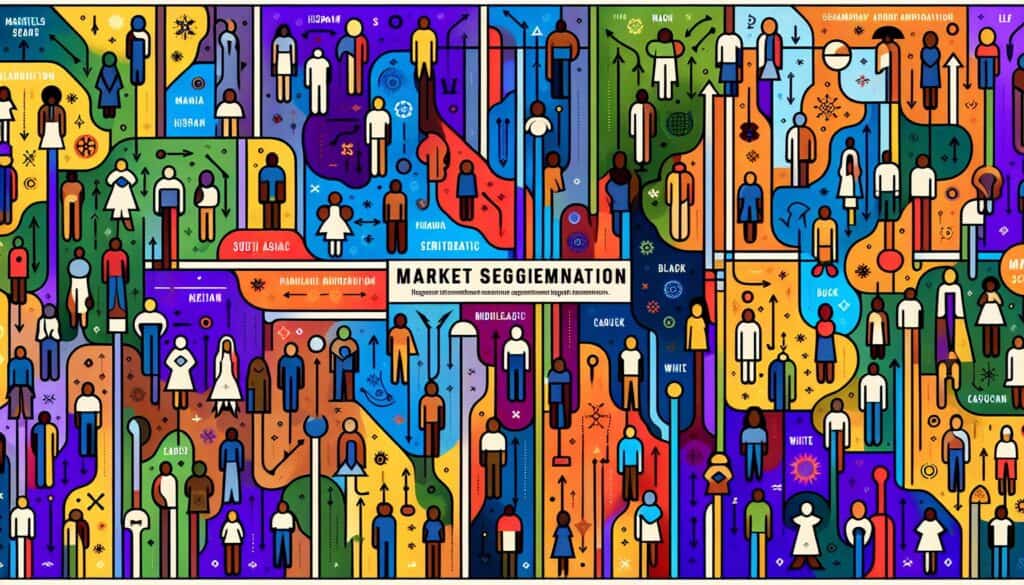To divide a broad target market into smaller, more defined subgroups of consumers who have common needs, interests, and priorities.
- المنهجيات: إدارة المشاريع
Market Segmentation

Market Segmentation
- تجربة العملاء, تخطيط رحلة العميل, أبحاث السوق, تسويق, استراتيجية التسويق, تمايز المنتجات, تحديد موقع المنتج, الجمهور المستهدف, القيمة المقترحة
الهدف:
كيفية استخدامه:
- Identifying key characteristics (e.g., demographic, geographic, psychographic, behavioral) to group potential customers, allowing businesses to tailor marketing strategies and product offerings to specific segments.
الايجابيات
- Enables more targeted and effective marketing; helps identify new market opportunities; can lead to increased customer satisfaction and loyalty.
سلبيات
- Can be costly and time-consuming to research and implement; segments must be accessible and substantial enough to be profitable; consumer preferences can change over time.
الفئات:
- العملاء والتسويق
الأفضل لـ
- Dividing a broad market into distinct subgroups to tailor marketing efforts and product offerings more effectively.
Market segmentation is often utilized across various industries such as consumer goods, technology, healthcare, and automotive, playing a significant role in the design and development phases of products and services. In sectors like consumer electronics, companies segment the market based on age and technological proficiency, enabling the creation of user-friendly interfaces for older adults or high-tech features for younger consumers who are more adept with advanced technology. The initiative for segmenting markets typically comes from marketing teams, product managers, and data analysts who work collaboratively to analyze demographic data, online behaviors, and purchasing patterns. For instance, real estate firms often segment their market geographically to focus on urban versus suburban buyers, tailoring property features, and marketing messages to fit localized preferences. Psychographic segmentation can inform branding strategies by identifying the values and lifestyles of different consumer groups, such as eco-conscious buyers who prioritize sustainable products. Behavioral segmentation delves into consumer habits, allowing companies to create loyalty programs that cater specifically to frequent buyers or those who engage with the brand on social media. The process can result in discovering untapped markets, as organizations gain familiarity with niche audiences, which can lead to enhanced customer satisfaction through offerings that resonate well with each group’s unique needs and preferences. This systematic approach not only refines marketing communications but also enhances the overall product experience, fostering long-term relationships with customers driven by personalized engagement.
الخطوات الرئيسية لهذه المنهجية
- Define the overall market and its size.
- Identify relevant segmentation variables: demographic, geographic, psychographic, and behavioral.
- Develop profiles for each segment based on identified characteristics.
- Evaluate the attractiveness and feasibility of each segment.
- Select target segments for marketing efforts and product development.
- Design customized marketing strategies for each selected segment.
- Implement the strategies and monitor performance across segments.
- Adjust strategies as needed based on feedback and market changes.
نصائح للمحترفين
- Utilize advanced analytics tools to identify and visualize patterns within customer data, enabling more precise segmentation.
- Conduct ethnographic research to uncover deep-rooted consumer behaviors and preferences that quantitative data might overlook.
- Implement iterative testing of segment-specific marketing strategies to adapt and optimize offerings based on real-time customer feedback.
لقراءة عدة منهجيات ومقارنتها, نوصي باستخدام
> مستودع المنهجيات الشامل <
مع أكثر من 400 منهجية أخرى.
نرحب بتعليقاتكم على هذه المنهجية أو المعلومات الإضافية على قسم التعليقات أدناه ↓، وكذلك أي أفكار أو روابط متعلقة بالهندسة.
السياق التاريخي
1960
1980
1983
1990
1995
2000
2010
1950
1980
1980
1986
1994
1995
2000
(إذا كان التاريخ غير معروف أو غير ذي صلة، على سبيل المثال "ميكانيكا الموائع"، يتم تقديم تقدير تقريبي لظهوره الملحوظ)














منشورات ذات صلة
استبيانات الانزعاج العضلي الهيكلي
الاختبار متعدد المتغيرات (MVT)
تحليل الانحدار المتعدد
أنظمة التقاط الحركة
طريقة MoSCoW
اختبار متوسط المزاج